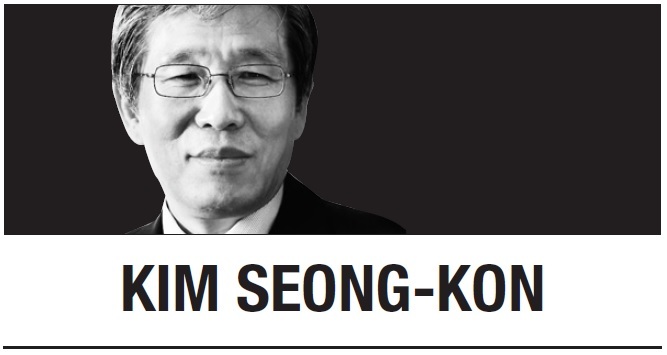
In the early 1980s when I began teaching at Seoul National University, I had my students watch George Romero’s legendary film, “Night of the Living Dead” in one of my graduate classes. At that time, very few Koreans even knew what a zombie was. Accordingly, my students at SNU were shocked and appalled at the bone-chilling horror of the first modern zombie film released in 1968.
After we watched the movie, I then taught my students how to read the film. For example, I compared the classic zombie film to the social and political milieu of late 1960s America, which included the spaceship technology competition, racism, and political assassinations. Then I encouraged them to discuss the film in the context of political battles between the political left and right, liberalism vs. conservatism, and Marxism vs. capitalism. We also discussed the film’s motifs, such as the duality between good and evil, us and them, and open society vs. the closed society.
Indeed, there is much more to zombie movies than horror. Lately, Korea has produced some internationally acclaimed zombie films and TV dramas full of socio-political implications, such as “Train to Busan” and “Kingdom.” These days, another Netflix Korean television series, “All of Us Are Dead,” enjoys worldwide popularity.
While watching “All of Us Are Dead” on Netflix, I found that this TV drama, too, implicitly reflects our contemporary society. It is noteworthy that this zombie apocalypse drama is set in a high school, a setting that reflects the cradle of our future generation and a microcosm of our society. This choice of setting suggests that “All of Us Are Dead” can be read as a powerful indictment against those who have turned our high schools into a hellish, inhumane place of survival of the fittest and fierce competitions for college entrance, not to mention an ideological incubator.
At Hyosan High School, a science teacher’s experiment goes wrong and inadvertently creates a zombie virus. His intention was good; he created the virus in order to make his bullied son strong and tough. Unfortunately, however, the virus turns into a zombie plague that spreads rapidly. What happens to the virus seems linked to the science teacher’s personal grudges: he is consumed with anger and the desire for revenge because of the principal’s nonchalance and incompetence to punish the bullies who ostracize his son.
The science teacher resembles our politicians who may have good intentions initially, but ruin our society in the end when their experiments go awry. The science teacher also reminds us of our left wing politicians obsessed with anger and political revenge under the banner of social justice and equality. On the other side, the principal, who seriously lacks a sense of crisis and leadership, could be a metaphor for our rightwing politicians. Caught in between, innocent students, who symbolize ordinary people, become helpless victims.
The zombie virus turns out to be as highly contagious as a radical political ideology. When vulnerable teenagers are brainwashed with a political ideology at school, it can turn them into completely different people, just as humans turn into zombies. In that sense, the science teacher, who is responsible for the spread of the zombie virus, may symbolize radical teachers who infuse an ideology they blindly worship and stubbornly implant them into their students’ minds.
As the school is run over by zombies, students are sharply divided by the good and the bad, us and them, and the normal and the abnormal. Even the survivors suffer mutual distrust and grow suspicious of one another as potential carriers of the zombie plague. Given over to this relentless paranoia due to their extreme situation, the students exhibit a selfish, evil nature, resembling the zombies they detest and fear.
In “All of Us Are Dead,” the government is hopelessly incompetent and irresponsible. It does not attempt to rescue the survivors at school. Instead, it just imposes martial law, isolating Hyosan City, and destroying the school and surrounding town by bombing and burning under the excuse of preventing the virus from dispersing to other cities. Thus, even the uninfected people are killed as collateral damage for the greater good. It reminds us of what the military dictators did to the city of Gwangju when there was an uprising in 1980.
After bitten by a zombie, some students become half-human, half-zombie. The drama ends with the possibility that those who are in a half-zombified state are living among us, pretending to be humans. Someday, they may be prevalent in our society. Whether they are good or bad, we do not yet know. It resonates with the ending of the American movie, “I am Legend,” in which new mutant zombies/vampires become predominant and begin a new civilization.
The original Korean title of the film is “Now at Our School.” When we add it to the film title, it can be a solemn admonition: “All of us are dead now at our school.” Before such a dreadful thing happens, we should be vigilant and wide awake.
Kim Seong-kon
Kim Seong-kon is a professor emeritus of English at Seoul National University and a visiting scholar at Dartmouth College. The views expressed here are his own. -- Ed.





![[Exclusive] Hyundai Mobis eyes closer ties with BYD](http://res.heraldm.com/phpwas/restmb_idxmake.php?idx=644&simg=/content/image/2024/11/25/20241125050044_0.jpg)
![[Herald Review] 'Gangnam B-Side' combines social realism with masterful suspense, performance](http://res.heraldm.com/phpwas/restmb_idxmake.php?idx=644&simg=/content/image/2024/11/25/20241125050072_0.jpg)

